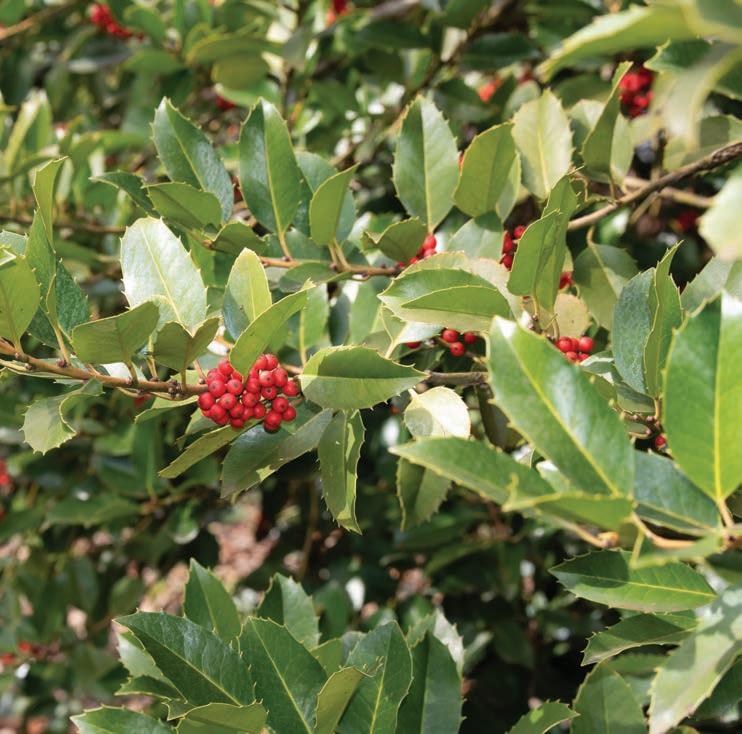
3 minute read
Ilex in the Nursery—Fits Within an IPM Approach
By Stanton Gill, Central Maryland Research and Education Center, University of Maryland; Professor, Montgomery College, Landscape Technology Program
Nursery owners are looking for plant material that grows quickly and sells into the planting screening market. Everyone who buys a new house wants to have a barrier planting that screens out their neighbors. Many Leyland cypress, Thuja ‘Green Giants’, and ‘Emerald Green’ arborvitae are filling this need. The nursery industry needs to diversify and pick a few other species. If we keep putting out the same old options, I guarantee we will see insect and disease problems hitting this limited number of plants. Plant diversity is one of the pillars of an IPM approach to dealing with potential pest problems.
Advertisement
One of the holly groups that holds up well as barrier, or even as specimen plant, is Ilex × koehneana. We have been growing this holly at the farm for the last 18 years, and it holds up well in winter weather. Bill Kuhl, of McLean Nursery, introduced me to this hybrid cultivar years ago. The plant has performed well, riding through the polar vortex and polar express -8 °F weather of those two events with no real damage showing up the following spring.
The cut stems root fairly easily, and the plant has strong vigor. This plant is dioicous (meaning: two houses), so you have female and male plants. The berries are large and borne on one-year-old wood. The leaves are large and dark green. There are female plants that need a male pollinator to set fruit. Males are more vigorous and serve well as border plants that block out views. Bill Kuhl showed me two-year-old male plants that were 3 to 4 feet tall. He commented that males grow much faster than females. This makes it perfect for growing as a screening plant, just using male plants.
Ilex × koehneana, female plant.
The hybrid name koehneana honors Bernard Koehne (1848–1918), a German botany professor. Here is a brief description and genology and some of the plant’s attributes:
• Ilex × koehneana, commonly called
Koehne holly, is a cross between
I. aquifolium and I. latifolia.
• It is an erect, narrow-pyramidal, densely-branched, large, hybrid evergreen shrub or small tree that typically grows to 15 to 25 feet tall with a spread 10 to 15 feet wide.
• Branches are clad with glossy, spiny-margined, elliptic, evergreen, dark green leaves (2 to 3 inches long).
• Inconspicuous, tiny, greenishwhite flowers bloom in May.
• Flowers are fragrant but generally inconspicuous. Pollinated flowers give way to berry-like red drupes (1/3-inch diameter) that ripen in fall and persist into winter.
Female Hollies
‘Lassie’ is a female holly that never fails to set fruit if a pollinator is nearby. It seems to be the earliest in its family to set fruit, even fruiting the first year. The berries are shiny, vivid red, and 5/16 inches (7.9 mm) in diameter. ‘Martha Berry’ is a new introduction that looks good.
Male pollinators include I. × koehneana cultivars ‘Ajax’, ‘Chieftain’, ‘Jade’, and ‘Loch Raven’, and ‘Apollo’, although English and other hybrid male hollies that bloom at the same time will do.

Ilex verticillate—Poor Berry Set?
I have had inquiries from some nursery growers saying they had a poor fruit set on their winterberry plants, Ilex verticillata. I visited with Bill Kuhl of McLean Holly Nursery to discuss a solution. Bill told me that many people use ‘Jim Dandy’ as their male pollinator, which works for some but not all female winterberry females. Bill suggested that the male ‘Apollo’ had a long bloom time that started as early as ‘Jim Dandy’ but lasted longer into the season, with pollen sources fertilizing mid-season blooming winterberry.
‘Jim Dandy’ is great, but it is a slowgrowing, early-flowering dwarf male clone. This cultivar is useful as a pollinator for early-flowering female clones such as ‘Afterglow’, ‘Aurantiaca’, and ‘Red Sprite’. It grows to about 5 feet tall.
For late-flowering female winterberries, he suggested using ‘Southern Gentleman’. This plant is a lateblooming male pollinator for ‘Winter Red’, ‘Winter Gold’, ‘Cacapon’, ‘Shaver’, ‘Sparkleberry’, and other later blooming female clones. If you are not getting the fruit set you desire, then look into adding other male cultivars into your planting.





